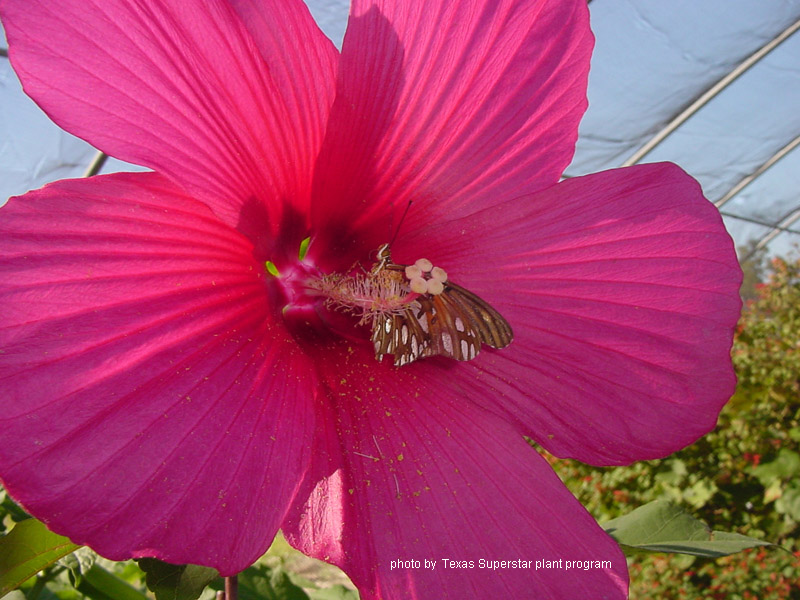Make a Splash
encore date: May 19, 2016
original air date: May 21, 2016
Want wildlife? Add water! Bj Jenkins and Ted Paone preview 2016’s Austin Pond Society tour where ponds tiny and big prompt outdoor living and wildlife watching. On tour, Barbara and David Hale created an everyday vacation destination in their shady backyard with ponds, waterfall and palapa. Daphne Richards answers: what’s wrong with my oak tree leaves? Go for bold with Plant of the Week Moy Grande hibiscus, sporting flowers the size of dinner plates. Trisha Shirey’s got sage advice on how to grow persnickety sage to flavor our recipes and bring on the bees.

 Moy Grande hibiscus, also known as Texas giant hibiscus, plant was developed in San Antonio and is well-loved by many Texas gardeners.
And being hardy to zone 5, which is -20 degrees F, this wonderful plant has made its way much farther north as well.
Moy Grande is a hybrid descendant of the tropical hibiscus, which can’t survive winter of any sort, and hibiscus species native to the southern US, which have more tolerance for a bit of chill.
With flowers as large as a serving platter, it’s easy to see why so many gardeners love this hardy perennial.
For best growth, plant Moy Grande hibiscus in full sun and in a well-drained area of the landscape. Garden beds that have been amended with some compost or other organic matter to create rich, moist soil work best, but if planted in light shade and less ideal soil, Moy Grande will still do just fine.
Being a root hardy perennial, this plant will lose all of its leaves once cold temperatures arrive and the above ground stems will eventually die back as well. In late winter, cut all the above-ground portions back to the ground to allow all new growth to emerge from the roots.
As with many hardy, shrubby perennials, Moy Grande can get rather monstrous in just a few years, so give it plenty of space. When you buy this plant in a one-gallon container, it’s hard to believe that it will get 4 feet tall and 6 feet wide, but it will, and rather quickly. Once mature, those stems will become a bear to prune every spring, but most gardeners will agree that’s a small price to pay for such a beautiful, easy-care plant.
Moy Grande has no pest issues to speak of and requires very little water to survive and thrive. Those dinner-plate-sized flowers are also well-loved by bees and butterflies. Flowering from mid-summer through early fall, Texas giant hibiscus provides delightful color in the garden right through the hottest times of the year, when many other blooms have faded and withered under the harsh summer heat.
Moy Grande hibiscus, also known as Texas giant hibiscus, plant was developed in San Antonio and is well-loved by many Texas gardeners.
And being hardy to zone 5, which is -20 degrees F, this wonderful plant has made its way much farther north as well.
Moy Grande is a hybrid descendant of the tropical hibiscus, which can’t survive winter of any sort, and hibiscus species native to the southern US, which have more tolerance for a bit of chill.
With flowers as large as a serving platter, it’s easy to see why so many gardeners love this hardy perennial.
For best growth, plant Moy Grande hibiscus in full sun and in a well-drained area of the landscape. Garden beds that have been amended with some compost or other organic matter to create rich, moist soil work best, but if planted in light shade and less ideal soil, Moy Grande will still do just fine.
Being a root hardy perennial, this plant will lose all of its leaves once cold temperatures arrive and the above ground stems will eventually die back as well. In late winter, cut all the above-ground portions back to the ground to allow all new growth to emerge from the roots.
As with many hardy, shrubby perennials, Moy Grande can get rather monstrous in just a few years, so give it plenty of space. When you buy this plant in a one-gallon container, it’s hard to believe that it will get 4 feet tall and 6 feet wide, but it will, and rather quickly. Once mature, those stems will become a bear to prune every spring, but most gardeners will agree that’s a small price to pay for such a beautiful, easy-care plant.
Moy Grande has no pest issues to speak of and requires very little water to survive and thrive. Those dinner-plate-sized flowers are also well-loved by bees and butterflies. Flowering from mid-summer through early fall, Texas giant hibiscus provides delightful color in the garden right through the hottest times of the year, when many other blooms have faded and withered under the harsh summer heat.